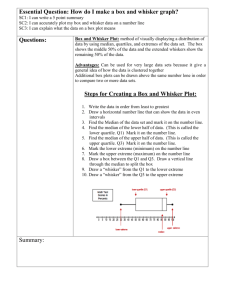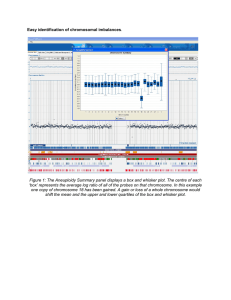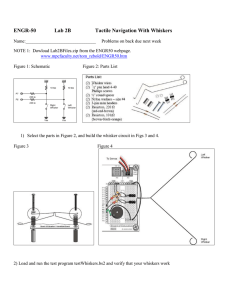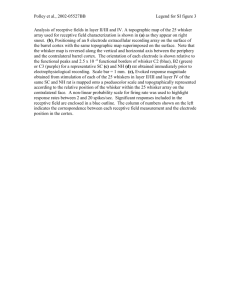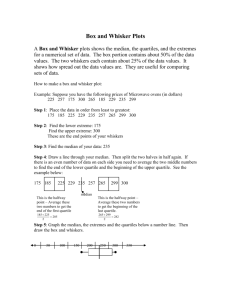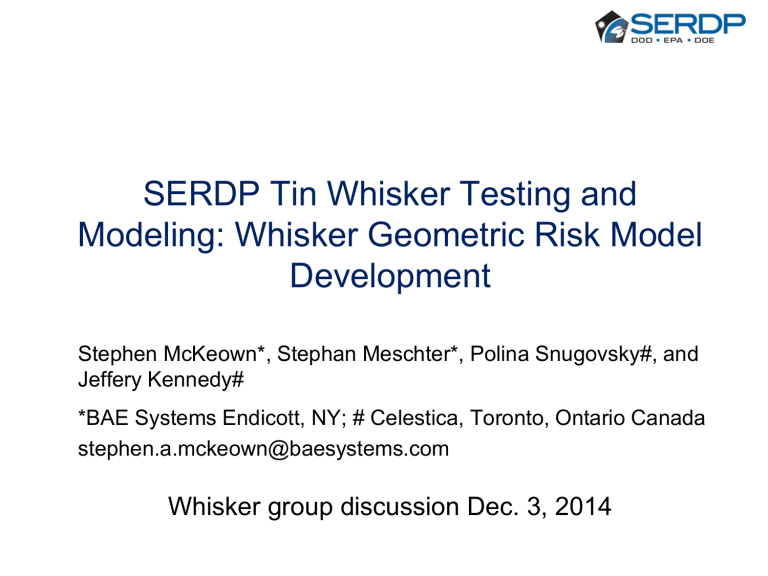
SERDP Tin Whisker Testing and Modeling: Whisker Geometric Risk Model Development Stephen McKeown*, Stephan Meschter*, Polina Snugovsky#, and Jeffery Kennedy# *BAE Systems Endicott, NY; # Celestica, Toronto, Ontario Canada stephen.a.mckeown@baesystems.com Whisker group discussion Dec. 3, 2014 Tin Whiskers Electrical short circuits Intermittent if current is more than 10s of mA Permanent if current is less than 10s of mA Found recently in accelerator pedal position sensor (H. Leidecker, L. Panashchenko, J. Brusse, “Electrical Failure of an Accelerator Pedal Position Sensor Caused by a Tin Whisker and Investigative Techniques Used for Whisker Detection” [1]) Debris/Contamination Short circuits Interferes with optical paths and MEMS Metal Vapor Arc Whisker shorts can vaporize into a conductive plasma able to conduct hundreds of amps http://www.calce.umd.edu/tinwhiskers/mva50V70torr.html © Copyright 2014 BAE Systems 2 Whiskers: Description Metals that grow whiskers include Metallic whiskers are crystalline filamentary structures Grow outward from metal surfaces More commonly found in electrodeposited Sn coating and Sn based alloys Shape Filaments Straight Kinked Spiral Nodules Odd-shaped eruptions Typical length strongly dependent upon circumstances Tin, Zinc, Cadmium No whiskers, 10 µm, 500 µm, 1 mm, 10 mm, 25 mm Typical thickness – 0.5 to 50 microns Whisker density varies greatly – no whiskers to over 1000 mm2 © Copyright 2014 BAE Systems 3 SERDP WP1753 Technical objective Perform systematic tin-whisker testing to improve the reliability of military electronics Provide an understanding of the key design, manufacturing, and environmental variable combinations that can contribute to whisker growth Evaluate conformal coating for mitigation effectiveness Provide metallurgical analysis of tin whiskers for nucleation and growth-mechanism formulation Provide an analytical framework to assess functional risk of whiskers to military electronic systems Provide a staged approach to risk modeling Physical geometry spacing distribution for various lead types System function risk assessment through integration of whisker distribution data and circuit details © Copyright 2014 BAE Systems 4 Whiskers in Pb-free solder joints Exposed Sn No lead(Pb) in electroplated Sn finish – propensity for whisker formation Poorer wetting – more exposed Sn plating for same type of components More aggressive fluxes to improve wetting – ionic contamination, oxidation and corrosion promoting whisker growth Sn-Ag-Cu solder – what about whisker growth? Rough surface – trapped contamination, difficult to clean – higher propensity to whisker Solder Shrinkage void cross-section top view Lead-free solder joint roughness, SEM © Copyright 2014 BAE Systems 5 Risk modeling: Gull wing leaded parts Flat pack (leads on 2 sides) Quad flat pack (leads on 4 sides) Note: Users should NOT neglect the concern of LARGE SURFACE AREA structures that may be tin or zinc coated. Things such as connector shells, bus bars, RF shields, fasteners, metal can packages, etc, provide a much larger surface area from which whiskers may form (i.e., greater opportunity for many whiskers). These are often tin or zinc plated and also used in reasonably close proximity to adjacent shorting sites Gull wing parts have among the closest lead-to-lead gap spacing with large opposing source/target areas © Copyright 2014 BAE Systems 6 How many leads are there in a box? [3] One electronic box Description # of leads # of gaps Analog 1 Power Supply 2009 326 1787 228 Digital 1 2573 2418 CPU 1144 1038 CPU-MEZZ 2512 2478 Risk increases with gap quantity Quad redundant control system - or Vehicles - or Fleets © Copyright 2014 BAE Systems How many gaps are there in a function? [3] The majority of the gaps occur with fine pitch parts having the highest bridging risk (e.g. smallest gap spacing) 435 gaps 19 components 250 198 Count 200 Circuit card # of components # of gaps 150 178 gaps 15 components Electronics Box 93 100 76 42 50 26 3 3 60 48 1 1 11 1 14 4 4 Part 18 1 1 14 24 Gap 4 0 Minimum lead gap (mm) © Copyright 2014 BAE Systems 8 Proximity based whisker bridging risk model First effort [1] • 3D to equivalent parallel plate • One whisker characteristic • No conformal coat Current work • Straight segment 3D • Lead, solder, pad whisker growth regimes • Variable area conformal coat • Multiple part roll-up • Bridging probability (Monte Carlo) • Short circuit probability © Copyright 2014 BAE Systems 9 Monte Carlo short circuit modeling approach Create bridging-risk model for various part types • Monte Carlo developed lead-to-lead spacing distribution for various lead geometries and whisker angle distributions • Time-independent model Conformal coat mitigation • Adjust whisker length, density, and diameter statistics • Modify target area based on coverage data • Modify source area based on “tenting” ability of coating Information on whiskers: Length, density, diameter, etc. • Data generated herein • Published data • Time and environment captured in whisker length, density, angle and diameter distributions Use model to evaluate bridging risk • Select representative digital, analog, and power circuits • Compute total assembly whisker bridging for a give whisker length distribution Evaluate published data on whisker electrical properties [2] Apply data to a failure modes and effects analysis to determine functional impact Evaluate overall risk of electrical functional impact • Obtain a probability of each effect © Copyright 2014 BAE Systems 10 Whisker short circuit modeling approach SHORT CIRCUIT RISK MODEL INPUTS Whisker length independent Part type Create simplified lead/solder geometry model Part lead and solder geometry data Conformal coating coverage Whisker growth angle distribution Whisker length distribution and density [based on: materials (part lead, solder and board pad), environment and exposure time] Number of lead pairs Circuit voltage Determine bridging whisker view factor Monte Carlo analysis used to determine whisker spacing distribution Determine whisker bridging probability Determine bridges per lead pair Determine overall bridging probability Apply electrical conduction distribution Obtain total short circuit probability © Copyright 2014 BAE Systems 11 Bridging whiskers Source whisker “sees” the target • Will it hit? • If yes, how long is whisker Mirror concept reduces geometry related whisker bridging calculation time © Copyright 2014 BAE Systems 12 Assumptions Conservative Whisker conduction probability is based on gold probe against tin rather than tin-tin contact Non-conservative Whiskers from opposite surfaces are not interacting No electric attraction between whiskers and substrates or between whiskers on adjacent surfaces is modeled Whisker in video is ~ 10 microns in diameter with 50V applied https://nepp.nasa.gov/whisker/experiment/exp4/index.html Smaller diameter whisker would require less voltage to move Longer whisker would be easier to move with a given voltage Electrostatic charge on the insulator ~couple kV charge https://nepp.nasa.gov/whisker/video/Zn-whiskers-HDG-electrostatic-bend.wmv Whiskers are not moving due to air currents No dueling sabers modeled Whiskers changing azimuth angle during growth and hitting other whiskers is not modelled https://nepp.nasa.gov/whisker/video/whisker-motion-air.mpg Other Metal vapor arcing not considered https://nepp.nasa.gov/whisker/anecdote/2009busbar/index.html © Copyright 2014 BAE Systems Bridging risk model t Non-bridging whisker Lead Target area WL Define geometry Solder H Source Bridging whisker WP f A LL LP Pad Gull wing (for QFP, SOT, etc) Whisker View Factor: Probability of an infinitely long whisker bridging from either lead Monte Carlo simulation of whiskers that could bridge from source to target Input: Source, target and coating geometries and whisker angle and azimuth distributions Whisker angle and azimuth distributions: Uniform (assumption) Example: QFP Lead Generate 1,000,000 infinitely long whiskers on source View factor 160,000 bridge to target (16%) 840,000 miss © Copyright 2014 BAE Systems Whisker spacing distribution Distance from source to target for whiskers that bridge Modeling: Lead spacing and whisker length Whisker spacing distributions created for various parts Whisker angle and azimuth distributions: Uniform (assumption) =1 = 1.2 Lead whisker spacing distribution (Also done for solder and pad) 15 Target Whisker spacing Ex: to Nominal spacing ratio Source Nominal spacing Whisker spacing distribution is a cumulative fraction of bridgeable spacing distances relative to nominal spacing Whisker length Whisker length distribution Cross correlation of distributions gives whisker bridging probability © Copyright 2014 BAE Systems BAE Systems / Celestica © 2013 Modeling: Overall short circuits 1) Whiskers per lead = Whiskerable area x Whisker density 2) Bridges per lead pair = whiskers per lead x whisker view factor (having coating adjustments) x whisker bridging probability 3) Bridges per assembly = Bridges per lead pair x Number of parts x Number of lead spaces 4) Short circuits per assembly = Bridges per assembly + Voltage+ Voltage shorting probability Whiskerable area for various parts Shorting probability versus applied voltage (Courey [5]) 16 © Copyright 2014 BAE Systems Real life considerations: Conductor-to-conductor gap spacing Nominal pad design J-STD-001 Class 3 TQFP64 after 4000 hours 85C/85%RH assembly allowance Pad 228.6 microns Lead 60 microns 1.6 mm 400 micron pitch 25 % lead overhang maximum 171.4 microns 109 microns (Cu thickness = 63 microns) Gap spacing reduction by board fabrication etch tolerances, lead misalignment, and a bulbous solder joint 17 © Copyright 2014 BAE Systems Real life considerations: Conformal coating coverage Conformal coating coverage assessment of low VOC spray coating Optical image Isometric SEM image • The white color in the SEM images indicates that the coating thickness is less than three microns • No coating behind the lead • 90% front, 50% side and 0% back • = 40% uniform coating model value © Copyright 2014 BAE Systems 18 SERDP 85 C/85RH HTHH 1,000 vs. 4,000 hrs [4][5] 1,000 hours 4,000 hours Significant additional nucleation Copper alloy lead 64 pin quad flat Alloy 42 lead SOT6 with a 0-0 pack (QFP64 U08, lead 28) (U65, lead 4) 0-0 contamination 19 © Copyright 2014 BAE Systems Whisker parameters: Length reference distributions Tin source Thickness (microns) 3 to 25 SAC305 Solder [4][5] 3 to 25 Plated Sn [6] Plated Sn Dunn [7] evaluated in [8] Substrate Copper board pads (clean parts and board) Copper board pads (contaminated parts and board) 5 to 9 Copper C194 7 to 9 Nickel plating over Copper C194 5 Copper plated brass (specimen 11) Environmental exposure Maximum Lognormal µ observed whisker (ln mm) length (microns) 76 -4.978 Lognormal σ 0.710 1,000 hours 85°C/85 %RH 2.5 years room, 1,000 cycles 55 to 85°C, 2 months 60°C/85%RH 15.5 years: 3.5 years room temp. and humidity, 12 years in a dessicator with dry room air Density (whiskers /mm2) 297 to 1,454 (4,000 hr level) 186 (Note 1) -4.795 0.6962 39 -4.571 0.9866 2,192 to 3,956 greater than 200 (Note 1) -4.306 0.8106 126 to 3,573 1,000 maximum specimen 11 length -2.651 0.9212 733, average of specimen 11 maximum lengths at various locations © Copyright 2014 BAE Systems Not available -2.783 0.8592 20 Whisker parameters: Density Whisker count for SOT5 at 0-0 Cleanliness level 4,000 hr 85 C/85RH 3 1 Unsoldered Lead length 4 5 Whiskers per board pad Whisker density (whiskers/mm2) Minimum 58 297 Maximum 284 1454 Maximum Average 182.8 936 Average Minimum 2 Soldered area 85C/85%RH High whisker density area Whiskers per lead on the side Whisker density (whiskers/mm2) 0 44 12.9 0 236 69 Maximum whisker density at the pad edge is 1454 whiskers/mm2 © Copyright 2014 BAE Systems 21 Example: Geometry inputs Default parameters PWB Pad Length over Lead Foot Length (mm) = PWB Pad Width over Lead Width (mm) = Fraction for Minimum Whisker Length Plot (Note 1)= Fraction for Maximum Whisker Length Plot (Note 1) = Use Geometric Mean for Midpoints (Note 2)= Lead Exit Fraction (*) (of package height) (Note 3) = Minimum First Bend Distance (*) (mm) = Pad Spacing Reduction from Solder Bulge (mm) (Note 4) = Relative Height of Bulge (Note 4) = Rounding Digits for Prompt Display = 1.04 0.111 5.00% 90.00% TRUE 50% 0.1 0.049 50% 4 Part Drawing Dimensions (mm): Package Height (A₂) = Package Seating Plane (A₁) = Lead Span (H) = Body Width (E) = Lead Foot Length (L) = Lead Thickness (c) = Lead Width (B) = Lead Pitch (e) = Lead Angle From Vertical (α deg) = Number of Leads = Number of Sides with Leads = 1.4 0.1 16 14 0.6 0.145 0.18 0.4 0 128 4 Calculated parameters Lead Spacing (mm) = Solder Spacing (mm) = Pad Spacing (mm) = Lead Thickness/Spacing (non-dim) = Lead Thickness/Solder Spacing (non-dim) = Lead Thickness/Pad Spacing (non-dim) = Lead View Factor Metric (non-dim) = Solder View Factor Metric (non-dim) = Pad View Factor Metric (non-dim) = © Copyright 2014 BAE Systems 128 TQFP 0.22 0.06 0.109 0.659 2.417 1.330 0.260 0.456 1.618 22 Example: Whisker parameter inputs Lead Lead Whisker Distribution (fill in green highlighted cells as appropriate): Distribution = 2 Whisker Density 69 (whiskers/mm2) = Whiskerable Area = 1.460 Total Whiskers Generated = Whisker Bridging Fraction = Whisker View Factor = Coating Effectiveness = Total Whiskers Bridging = 3-Parameter Lognormal Distribution: Whisker Minimum (0) = Whisker µ (location, ln(mm), 1.8965) = Whisker σ (scale,nondim, 1.5169) = 100.7 0.00% 0.101 0% 8.518E-11 -4.795 0.6962 Solder Pad Solder Whisker Distribution (fill in green highlighted cells as appropriate): Distribution = 2 Whisker Density = 936 Whiskerable Area = 0.533 Total Whiskers Generated = Whisker Bridging Fraction = Whisker View Factor = Coating Effectiveness = Total Whiskers Bridging = 3-Parameter Lognormal Distribution: Whisker Minimum (0) = Whisker µ (location,ln(mm), 1.8965) = Whisker σ (scale,nondim, 1.5169) = 498.6 0.01% 0.2485 0% 0.01149 -4.795 0.6962 © Copyright 2014 BAE Systems Pad Whisker Distribution (fill in green highlighted cells as appropriate): Distribution = 2 Whisker Density = 936 Whiskerable Area = 0.311 Total Whiskers Generated = Whisker Bridging Fraction = Whisker View Factor = Coating Effectiveness = Total Whiskers Bridging = 3-Parameter Lognormal Distribution: Whisker Minimum (0) = Whisker µ (location,ln(mm), 1.8965) = Whisker σ (scale,nondim, 1.5169) = 291.0 0.00% 0.311 0% 0.003275 -4.795 0.6962 23 Example: Whisker shorting results TQFP128 SAC305 soldered with no conformal coating Applied voltage of 5 volts Whiskers: 1,000 hour 85C/85%RH exposure with mildly contaminated parts and boards; lognormal µ = -4.795 ln(mm) and σ = 0.6962 Distributions 1-numerical, 2-lognormal, 3-log Cauchy, 4-Cauchy, 5-Weibull Lead Space Lead Whisker (2) Lead Bridge 0 0.05 Solder Space Solder Whisker (2) Solder Bridge Pad Space Pad Whisker (2) Pad Bridge Lead/Solder/Pad Bridge Interference (mm) 0.1 0.15 0.2 0.25 0.3 0.35 0.4 100 124 Applied Voltage = 5 Shorting Probability = Whisker Type: 10 Probability Density Function Total lead spaces = 1 V 41.4% Lead Solder Pad Bridges per lead: 6.24E-06 0.0115 0.003275 Bridges per part: 0.000774 1.425 0.406 Shorts per part: 0.00032 0.589 0.168 TOTAL SHORTS = 0.7577 0.1 0.01 0.001 0.0001 0 0.2 0.4 0.6 0.8 Spacing/Whisker Length (mm) 1 1.2 1.4 2 x 0.7577 = 1.5154 With two TQFP128 parts a short circuit failure is expected © Copyright 2014 BAE Systems 24 Example: Whisker shorting results TQFP128 SAC305 soldered with no conformal coating Applied voltage of 5 volts Whiskers: 1,000 hour 85C/85%RH exposure with mildly contaminated parts and boards; lognormal µ = -4.795 ln(mm) and σ = 0.6962 TOTAL SHORTS = Change cleanliness: 1,000 hour 85C/85%RH exposure with clean parts and boards; lognormal µ = -4.978 ln(mm) and σ = 0.710 TOTAL SHORTS = 0.7577 Add coating: 40 percent conformal coating coverage TOTAL SHORTS = 0.2486 Reduce shorts by 1/3 0.373 Change solder, remove coating: TQFP128 tin-lead soldered with no conformal coating Applied voltage of five volts (1,000 hour 85C/85%RH exposure with clean parts and boards; lognormal µ = -4.978 ln(mm) and σ = 0.710). TOTAL SHORTS = 0.00014 © Copyright 2014 BAE Systems 25 Summary Provides a means of comparing various Coating and tin-lead solder mitigations Component geometry types The partitioning of the calculation between the geometry and the whisker distribution allows rapid recalculation of short circuit risk as new whisker distributions become available. © Copyright 2014 BAE Systems 26 References [1] S. McCormack and S. Meschter, “Probabilistic Assessment of Component Lead-to-lead Tin Whisker Bridging” SMTA International Conference on Soldering and Reliability, Toronto, Ontario, Canada, May 20-22, 2009. http://nepp.nasa.gov/WHISKER/reference/reference.html [2] K. Courey, et. al, “Tin Whiskers Electrical Short Circuit Characteristics, Part II,” IEEE Trans. on Electronic Packaging Manufacturing, Vol. 32, No. 1, January 2009. http://nepp.nasa.gov/WHISKER/reference/reference.html [3] S. Meschter, S. McKeown, P. Snugovsky, J. Kennedy, and E. Kosiba, Tin whisker testing and risk modeling project, SMTA Journal Vol. 24 Issue 3, 2011 pp. 23-31. [4] S. Meschter, P. Snugovsky, J. Kennedy, Z. Bagheri, S. Kosiba; “SERDP Tin Whisker Testing and Modeling: High Temperature/High Humidity (HTHH) Conditions”; Defense Manufacturers Conference (DMC) December 2-5, 2013 Orlando, Florida [5] S. Meschter, P. Snugovsky, J. Kennedy, Z. Bagheri, E. Kosiba, and A. Delhaise, SERDP Tin Whisker Testing and Modeling: High Temperature/High Humidity Conditions, International Conference on Solder Reliability (ICSR2013), Toronto, Ontario, Canada. May 13-15, 2014. [6] Panashchenko, Lyudmyla; “Evaluation of Environmental Tests for Tin Whisker Assessment”; University of Maryland, Master’s thesis 2009 [7] Dunn, “15½ Years of Tin Whisker Growth – Results of SEM Inspections Made on Tin Electroplated C-Ring Specimens,” ESTEC Materials Report 4562, European Space Research and Technology Centre Noordwijk, The Netherlands; March 22, 2006 [8] McCormack, Meschter, “Probabilistic assessment of component lead-to-lead tin whisker bridging,” International Conference on Soldering and Reliability, Toronto, Ontario, Canada, May 20-22, 2009 © Copyright 2014 BAE Systems 27

